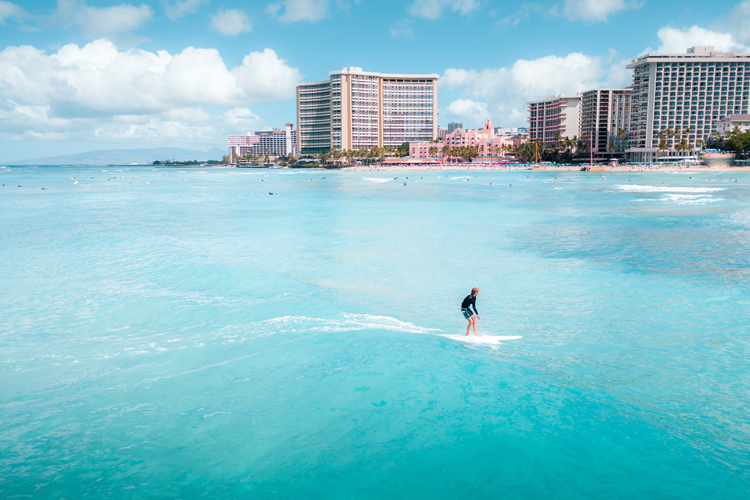After I had established a regular program for my return to surfing, I found things entirely different from the few days spent with [German photographer] Hanns Hubmann.
For the first month, I was still pretty weak, but I was stimulated by the competition from Larry and George, who were getting better fast.
I learned again that paddling was half the battle and that to paddle properly, you had to have the board at just the right angle, or it will not glide.
This is a few degrees above the horizontal.
If it is lower than this, the nose will go under, and if it is much higher, paddling is very difficult.
For best results, the tip should be an inch or two above the water, which is known as keeping a trim board.
As you prepare to take a stroke, you raise yourself on the board until your chest is eight inches or so above it and thrust your arms forward as far as you can reach, taking a double stroke, pulling hard through the water as you would when doing the butterfly.
This means you must use your shoulders to prevent the arms from becoming tired too quickly.
Some people prefer to paddle in the kneeling position, which is more common in California, where the water is cold and where the surfer can be recognized by his characteristic blue color.
It is more difficult for a beginner to hold his balance this way, but an experienced surfer often finds that a greater leverage and sweep is possible from this position.
This is especially true for apes, orangutans, and ordinary people with long arms.
When paddling in the kneeling position, I prefer my legs splayed a bit and my knees almost together, with the balls of my feet on the board, which again increases the leverage.
Many surfers, however, prefer their legs parallel a few inches in on the board with their insteps flat and the soles of their feet pointing toward the sky.
This method has the magnificent advantage of allowing one to commercialize on the soles of one's feet, which may be used for advertising; Jersey Joe Walcott initiated this epoch-making idea in his first fight with Joe Louis.
(He was not expected to win.)
Although few surfers will be able to resist the blandishments of commerce, repeated knee paddling sometimes induces bone-like "surfers knots" on the bursa over the knee-cap - a sort of surfing version of housemaid's knee, which apart from producing knobby knees of considerable ugliness, is extremely painful and has been known to require surgery.
Some surfers alternate between the prone and the kneeling position to relieve certain muscles when they are tired, but in the long run, your choice is largely a matter of personal comfort.
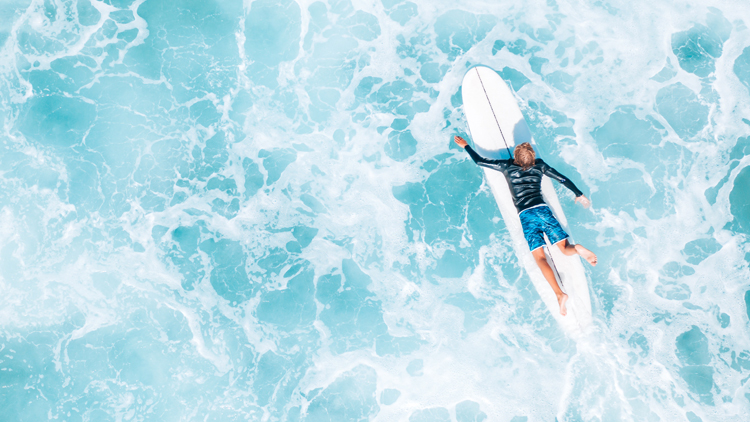
Building Surf Skills at Waikiki
When I began surfing again with Larry and George, they had been at it about a month, and in self-respect, I had tried to start at their level of proficiency.
I felt, quite wrongly as it turned out, that I was past the beginner's stage.
As has been suggested, a beginner should take lessons for the first week.
(Barry Napoleon says many of those surfing stories in James Michener's books are based on truth, girls!)
If you cannot afford lessons, you are better advised to catch broken waves with white water (soup) and ride them lying down.
For this, you must first paddle out to a point where the waves have broken.
After making sure you are in nobody's way, station yourself in the center of the advancing waves and wait for your opportunity.
When you have recovered from paddling out and fell ready for a wave, face toward the shore.
When the broken wave is about 20 yards away, start to paddle as hard as you can, although, at Waikiki, the soup will usually catch hold of you even if you do not match the speed of the wave.
The nose of the board should be at least four inches above the water for riding broken waves.
When you are in the wave, grab the rails (sides of the board) and hang on tight. Ride your first waves lying down until your confidence increases.
Most people need a week to build up their paddling muscles, and if they do not take lessons, they will appreciate a push from a surfing friend during this time.
This will mean that they are not restricted to white water and thus will get more practice.
As the wave approaches, your friend should give you a good push which is estimated to be at maximum speed just as the wave catches the board.
If it is too violent, the nose of the board will dip, and you will go into an undignified posture sliding into the sea in a so-called pearl dive and perhaps lose the board.
If it is not hard enough, you will not catch the wave.
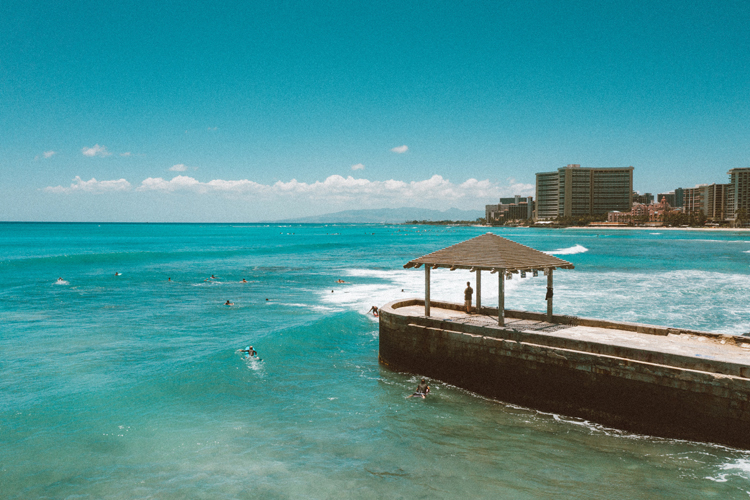
Be Patient
Many people have difficulty managing the board at this stage and give up in disgust. All I can say is don't be downhearted. Keep trying!
If it is any consolation, I have never known any person who persevered who couldn't stand up on the board by themselves in a couple of weeks, and have known several who did so the first day even without a push.
If you have trouble balancing the board while being pushed, try gripping the board with your hands around the rails and dead level with your shoulders.
This seems to give more control as the wave catches the board.
For people who are surfing the first two lanes of Canoe Surf, it is not necessary to be able to swim at all, but after you have got past the prone stage and are prepared to go into the deeper water, you should make sure your swimming is adequate.
Anyone surfing anywhere should be able to swim at least a quarter of a mile in a sea with some white water to combat - it won't be long after you start before you have to.
It is a good idea to practice jumping up and down in the surf and diving to the bottom - near your board if you are out of your depth - just to accustom yourself to falling off your board.
Also, try diving through broken waves.
Body surfing is the best possible type of training for board surfing.
Many other safety hints should come out in the ensuing text when I will further describe my own surfing adventures, such as they were, in the hope other beginners can avoid some of the pitfalls and learn by the experience.
The surf at Waikiki, except for a few days when there is a storm at sea, is quiet from November to April.
Waves over four feet high are seldom encountered, and often they are much less.
Consequently, this is an ideal period to learn, or at least to gather confidence for the bigger surf, which sooner or later must be negotiated for any kind of surfing proficiency.
The old adage "rough weather makes good pilots" also applies to surfing.
The surf in front of the Moana Hotel, from 6:30 to 8:00 am during the winter months, is almost deserted.
Larry and George and I were often the only people out there, although occasionally a superior-looking gentleman we called "Smiley" because of his serious mien would join us, although he never spoke to us.
We would all paddle out near the buoy, a distance of some five or six hundred yards, and await the waves.
On bad days they would be 15 or 20 minutes apart. On good days they would be almost continuous.
When you are learning, it's advisable to have friends around who can look out for you.
There is always that occasional wave that breaks where it shouldn't, and a beginner can very quickly get into distress.
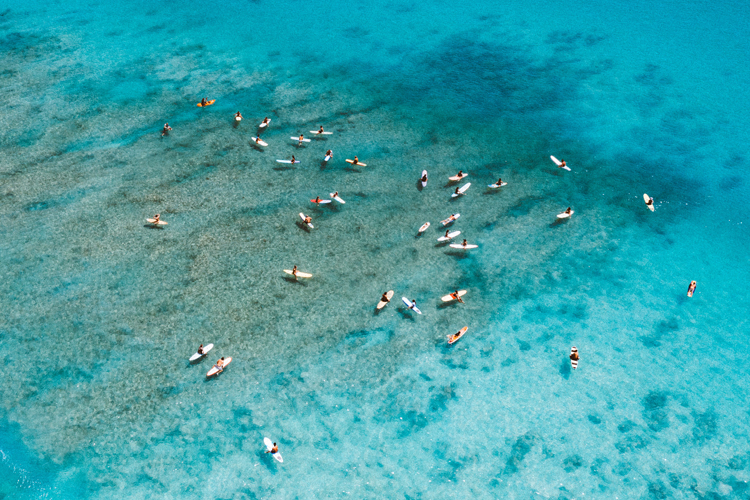
From Good to Great
During the first two weeks of renewed surfing activity, my paddling improved by leaps and bounds, I could feel my shoulders filling out and my stomach flattening.
It's like somebody squeezing you about the middle to improve your shape.
I also found that I could catch waves without a push from other people.
After selecting your wave - this improves with practice and eventually becomes almost an instinct - you start taking great raking strokes, lunging as far forward as you can to get the board moving fast.
Lifting your feet up in the air and banging them down on the board just as you take the stroke will increase your speed if you need this.
You have to paddle hard since the waves are usually more difficult to catch in the winter months.
At the same time, it is worth remembering that timing is terribly important, and a few good strokes just as the wave grips the board are worth a hundred careless thrashes.
In bigger and steeper waves, a single stroke or two plus a push on the board with the hands and feet in sharp succession as you get up will often suffice.
In this instance, you will go straight into a side slip so that your board is at an angle to the waves to start with - but it will be many months before you are good enough to begin the ride like this.
At first, you are better off to take the waves at right angles and ride straight ahead.
As you feel the wave catch the board, you should immediately stand up.
Many people will say put this or that foot forward, but in actuality, do what comes naturally. Just get up and be grateful.
You can learn the good posture position later. The board, by now, has momentum and is very steady.
You will not find the riding difficult unless the wave has broken and you are getting bumped about by heavy soup over shallow water.
I find that I place my hands flat on the board and push myself up with a movement so swift that I cannot recall how it happens.
Every wave is different in surfing, as is every day, and quick reflexes and an ability to improvise the situation are obviously essential.
Some surfers grasp the rails of the board with both hands and heave themselves up, but this takes a bit longer.
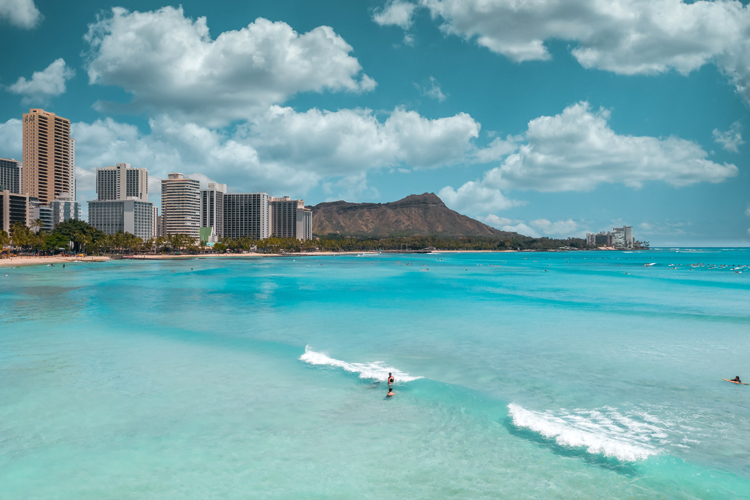
The "Goofy Foots"
Anyway, the important thing to do is to get up.
Once they are up, most people find they have their left foot forward, and their right foot behind pointed outward, almost at right-angles to the board; their knees are slightly bent, and the body is leaning slightly forward, with the arms hanging slightly outward like a wrestler but preferably in a relaxed and natural state.
This, or a variation of it, is the "good posture position" of champion surfers.
However, there are no absolute rules, and you can adopt the stance which you find most comfortable unless you want to compete in the International Surfing Meets.
Your weight should be on the heels at this point, acting slightly behind the board's center of gravity.
People who put their right foot forward are called "goofy foots." Personally, I find this position the most comfortable.
After two or three weeks of renewed surfing activity, I was beginning to feel much more confident.
The sea had not been high enough to have to indulge in any gymnastics in getting out to the surf (which will be treated later), and the surf itself had been most friendly - long glass walls about three or four feet high which had rippled in toward the beach with satisfying regularity.
If the waves broke at all, they merely bubbled and frothed into harmless white foam without crashing down like the summer breakers at Waikiki.
We were beginning at last to experience the incredible intoxication of life in the surf; speeding down the waves with that wonderful, rushing, roaring, skimming noise beneath us, knees bent, chests forward, hearts pounding, and heads in the incomparable Hawaiian air.
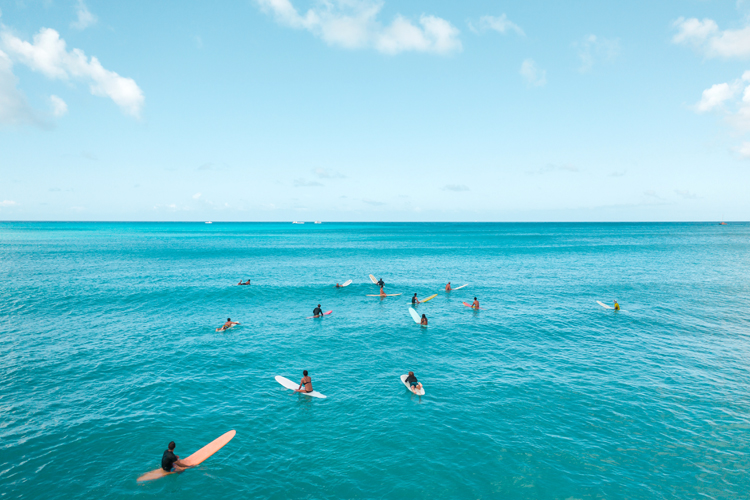
The Ultimate Fusion of Man With Nature
At last, the business world seemed relegated to its proper perspective, as the wind sang and hummed with the rhythm of a thousand harps and set our hair streaming and our skin burning.
We drifted, side-slipped, soared, and glided, with that suffusion of sailing and flying, which makes the experience of surfing almost impossible to describe.
I started again to wonder what exactly it was that made surfing the great sport that it is; the sport that gripped its addicts with such ardor that children became truants, teenagers became loafers or hoodlums, and grown men became vagabonds without visible means of support.
Quite suddenly, I knew.
It is, of course, many things. It is the isolation of man riding the very face of the sea while in touch with the clouds and the sky.
Land is seemingly far away, and with it, the problems and anxieties of our material civilization are temporarily banished.
Then again, it is the integration of man with the surf and with the sea; he becomes as one with them, and so discovers himself.
Man and board are as a centaur riding the waves so that for a short spell, they are indistinguishable, and all three unite with that sense of oneness and identification that man seeks all his waking life.
Surfing is thus the complete integration of man's natural body and spirit with the violent forces of nature in the most total and satisfying way possible.
But there is more than integration; there is also conquest, for surfing on good-sized waves requires daring and skill, grace and strength, all the finest human qualities which are pitted against the ever-changing uncertainty of the ocean.
And so the eternal paradox is again resolved - of man feeling the need to unite with nature, yet wanting to conquer nature at the same time.
At this juncture, surfing could quite validly be compared with other sports except for one striking difference.
That is the relationship to the sea itself - the sea which gives the surfer life.
The medium on which the sport is performed is not inert like snow or grass, for the wave below the surfer surges with almost unlimited power, a power which is transmitted to the rider of the board and which is triumphantly harnessed by him - without dynamos, outboard motors or complicated machinery - harnessed by puny man, who with the aid of a thirty-pound slab of plastic converts this unlimited power to do his bidding.
Surfing is, therefore, the ultimate fusion of man with nature and simultaneously the ultimate triumph of man over natural phenomena.
At Waikiki, the surfer is also involved with the pageant all around him.
Every day we wondered at our luck that we were sitting on a surfboard in this peerless "haunt where beauty dwells."
In the early morning, the gray light laughed on the sea's face, reflecting the white cloud puffs as they raced to greet the rising dawn.
The sea had a grave stillness, only broken by the lapping of the wavelets against the stationary board.
Looking left along the curved sweep of yellow sand toward the palm-fringed Halekulani, we were on a line drawn directly to the headland in the great protective arc which forms the bay at Waikiki.
Back beyond the Royal and the Moana was the deep green shadowed envelope of the Manoa Valley, and behind that the somber slopes of the rain-soaked Ko'olau.
One couldn't help wondering what other city in the world had surfing at its doorstep like Honolulu, and in such a setting.
In the radiant silence of that Hawaiian morning, we rose with the waves to execute the longest left slides of the year, and when at last the in came up over Diamond Head, it felt good to be alive.
I can still remember a remark made later by Barry Napoleon, the tall Hawaiian surfboard maker, as a bunch of us were sitting with our boards tilted upward, waiting for a new set of waves to come in.
"I wonder," he said, "what the rich people are doing now?"
Words by Desmond Muirhead | Golf Course Designer and Author of the Book "Surfing in Hawaii" (1962)
Chapter V of "Surfing in Hawaii" was published under the authorization of Rosemary J. Muirhead, one of the three daughters of Desmond Muirhead
